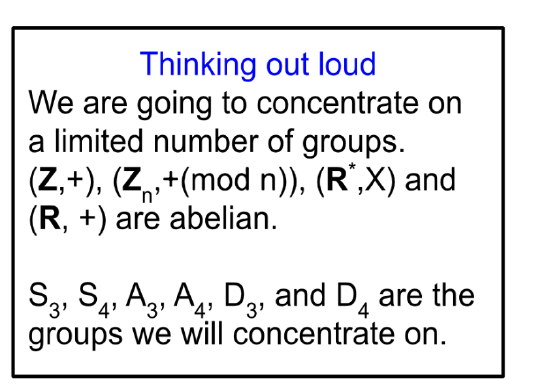4.2: Normal Groups and Factor Groups
- Page ID
- 132494
Let \( G \) be a group, and let \( H \leq G \). Then \(H\) is called a normal subgroup of \( G \) if \( g H g^{-1} =H (\,or\, gH=Hg), \forall g \in G ,\) denoted as \(H \unlhd G.\)
That is, normal subgroups are those that are invariant under conjugation by any element of the group.
Suppose \(H \le G \).
\(H \) is a normal subgroup of \(G \), if \(gH=Hg, \;\forall g \in G \). Means left cosets=right cosets.
Note if \(G \) is abelian, every subgroup is normal to \(G \). For any group \(G \), the trivial subgroups \(\{e\} \) and \(G \) are normal subgroups.
Consider \(S_3=\{e,(123),(321),(12),(13),(23)\}\).
-
Is \(H=\{e, (12)\}\unlhd S_3\)?
Since \((123)H=\{(123),(13)\} \ne H(123)=\{(123),(23\}\), thus \(H \not \unlhd S_3\).
-
Is \(A_3=\{\langle (123) \rangle\} \unlhd S_3\)?
\(A_3=\{e,(123),(321)\}\).
There will be 2 cosets of \(A_3\) in \(S_3\) since \(\frac{|S_3|}{|A_3|}=\frac{6}{3}=2\).
The first will be the set itself since \(eH=He=H\). To find the second, take any element
in \(S_3\), not in \(S_4\) and determine its coset. Having done so, the cosets are: \(A_3, \{(12),(13),(23)\}\).
Let \(G\) be a group, and \(H\) be a subgroup of \(G\). If \([G:H]=2\), then show that \(H\) is a normal subgroup of \(G\).
- Proof:
-
Let \(G\) be a group and \(H \le G\) s.t. \([G:H] =2\).
\(H\) partitions \(G\) into 2 cosets. The left cosets being \(\{ H, xH\}\). Similarly, the right cosets are \(\{H, Hx\}\) where \(x \in G\) and \( x \not \in H\).
Case 1:
If \(x \in H\) then \(xH=H=Hx\).
Since \(xH=Hx\), \(H \unlhd G\).
Case 2:
If \(x \in G\), but not in \(H\). We will show this as \(x \in G-H\).
Then \(xH = G-H =Hx\).
Since \(xH=Hx\), \(H \unlhd G\).
Thus \(xH=Hx, \; \forall x \in G\), thus \(H \unlhd G\).◻
Show that \(A_n\) is a normal subgroup of \(S_n, \; \forall \; n \in \mathbb{N}\).
Solution
Consider \(\frac{|S_n|}{|A_n|}=\frac{n!}{\frac{n!}{2}}=2\).
From previous theorem, given \(H \le G\) then if \([G:H]=2\) then \(H \unlhd G\).
Since \(A_n \le S_n\) and \([S_n:A_n]=2\), \(H \unlhd G\).◻
List all normal subgroups in \(D_4.\)
Solution
\(D_4=\{1, r, r^2, r^3, s, sr^2, sr^3\}\). Note that \(\{1\}\) and \(D_4\) are normal subgroups of \(D_4\).
Let \(N\) be a normal subgroups in \(D_4.\)
Let \(G\) be a group and let \(G^{'} = \langle aba^{-1}b^{-1} \rangle\), that is, \(G^{'}\) is the subgroup of all infinite products of elements in \(G\) of the form \(aba^{-1}b^{-1}\). The subgroup \(G^{'}\) is called the commutator subgroup of \(G\).
-
Show that \(G^{'}\) is a normal subgroup of \(G\).
Proof:
Let \(g \in G\) and \(h \in G^{'}\).
We will show that \(G^{'} \unlhd G\).
Consider \(h=aba^{-1}b^{-1}, a,b \in G\).
Then \(ghg^{-1}=gaba^{-1}b^{-1}g^{-1}\)
\(=geaebea^{-1}eb^{-1}g^{-1}\)
\(=(gag^{-1})(gbg^{-1})(ga^{-1}g^{-1})(gb^{-1}g^{-1})\) Note: \(g^{-1}g=e\)
\(=(gag^{-1})(gbg^{-1})(gag^{-1})^{-1}(gbg^{-1})^{-1} \in G'\).
Thus \(G^{'} \unlhd G\).◻
2. Let \(N\) be a normal subgroup of \(G\). Prove that \(G/N\) is abelian iff \(N\) contains the commutator subgroup of \(G\).
Proof:
Let \(N \unlhd G\).
We shall show that \(G/N\) is abelian if and only if \(N\) contains the commutator subgroup of \(G\).
Let \(G/N\) be abelian.
Let \(a,b \in G\).
We shall show that the commutator subgroup of \(G \subseteq N\)
Consider \((aN)(bN)=(bN)(aN)\) since \(G/N\) is abelian.
Thus, \(abN=baN\).
Thus \(ab(ba)^{-1} \in N\) Note: due to cosets.
Thus \(ab(ba)^{-1}=aba^{-1}b^{-1} \in N\).
Therefore the commutator subgroup of \(G \subseteq N\).
Conversely, let the commutator subgroup of \(G \subseteq N\) and \(a,b \in G\).
We shall show that \(G/N\) is abelian.
Since the commutator subgroup of \(G \subseteq N\), \(aba^{-1}b^{-1} \in N\).
Thus, \(ab(ba)^{-1}N=N\).
Thus \((aN)(bN)=(bN)(aN)\).
Therefore \( G/N\) is abelian.
Therefore \(G/N\) is abelian iff \(N\) contains the commutator subgroup of \(G\).◻
 Note: Let \(G \) be a group.
Note: Let \(G \) be a group.
If \(H \le G \) and \(K \le H \) then \(K \le G \). However, this does not work for normal sub groups. Thus given \(H\unlhd G \) and \(K \unlhd H \), it does not follow that \(K \unlhd G \), see the following example.
Let \( G=S_4, H= A_4, \) and \( K= \{e, (1,2)(3,4),(1,3)(2,4), (2,3)(1,4) \} . \)
Then \( H \unlhd G \) and \( K \unlhd H, \) but \(K \) is not a normal subgroup of \(S_4. \) That is \( K \not\trianglelefteq G. \)
let \(G \) be a group and \(H \le G \). Then the following statements are equivalent:
-
\(H \unlhd G \).
-
\(\forall \; g\in G, \; gHg^{-1} \subseteq H \).
-
\(\forall \; g \in G, \; gHg^{-1} = H \).
Simple Subgroups
A group \(G\) is called simple if \(G\) has no nontrivial normal subgroups.
\(\mathbb{Z}_2\) is simple since the normal subgroups are \(\{0\}, \mathbb{Z}_2\). \(\mathbb{Z}_p\), for prime \(p\) and \(A_n\) for \(n\geq 5\) are simple.
Factor Groups
Let \(G \) be a group and \(N \unlhd G \).
Thus \( \{gN|g \in G\} \) are all the cosets (ie, the set of sets) and this is defined as \(G/N= \{gN|g \in G\} \), which is a group with the operation of \((g_1N)(g_2N)=g_1g_2N \). If \(G \) is finite, the order \(|G/N|=[G:N] \).
We shall show that \(G/N\) is a group \(gN \star hN=ghN\) with \(\star\) being the operation in \(G\) .
Note: This is the process used to combine groups.
Let \(N=\) the identity of \(G\) .
Consider \(gN\star N=gN\star N=gN=N\star gN\) . Thus \(e_N\) exists.
The inverse of \(gN\star g^{-1}N=(gg^{-1})N=eN=N\) . Thus the inverses exist.
\(G /N\) is associative since \(G\) was associative.
Since \(G/N\) has an identity, has inverses for all elements, and is associative, \(G/N \le G\), which is called a factor group.
\(S_3/A_3=\{A_3, (12)A_3\} \).
Let \((\mathbb{Z}, +) \) s.t. \(n\mathbb{Z}=\{\ldots, -2n,-n, 0, n, 2n, \ldots\} \).
Is the subset a group? Yes since it is a non-empty set that contains the identity and \(gh^{-1}\in \mathbb{Z} \).
Therefore the set is a subgroup of \((\mathbb{Z}\) and because of addition, it is a normal subgroup of \((\mathbb{Z}\), algebraically, .
\(\mathbb{Z} / n \mathbb{Z}=\{\ldots , -1+n \mathbb{Z}, 0+n\mathbb{Z}, 1+ n \mathbb{Z}, \ldots \} \).
Let \(G\) be a group and \(Z(G)\) be the centre of \(G\). If \(G/Z(G)\) is cyclic, then \(G\) is abelian.
Ex


